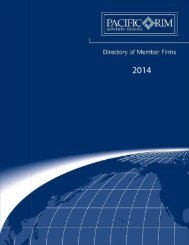A Guide to the Law of Securitisation in Australia - Clayton Utz
A Guide to the Law of Securitisation in Australia - Clayton Utz
A Guide to the Law of Securitisation in Australia - Clayton Utz
- No tags were found...
Create successful ePaper yourself
Turn your PDF publications into a flip-book with our unique Google optimized e-Paper software.
9 Insolvency and securitisation529.1 IntroductionIn securitisations <strong>in</strong> <strong>Australia</strong>, issuers are ei<strong>the</strong>r special purposecompanies act<strong>in</strong>g <strong>in</strong> <strong>the</strong>ir own right or trustee companies act<strong>in</strong>gas <strong>the</strong> trustee <strong>of</strong> a trust.In both cases <strong>the</strong> effect <strong>of</strong> <strong>the</strong> <strong>in</strong>solvency <strong>of</strong> <strong>the</strong> issuer on <strong>the</strong>securitisation program is crucial <strong>to</strong> an assessment <strong>of</strong> <strong>the</strong> risk for<strong>in</strong>ves<strong>to</strong>rs who acquire <strong>the</strong> program’s securities.In <strong>the</strong> case <strong>of</strong> a corporate issuer, <strong>the</strong> rat<strong>in</strong>g agencies need <strong>to</strong> beconfident that <strong>the</strong> assets <strong>of</strong> <strong>the</strong> company will be distributed uponits <strong>in</strong>solvency <strong>in</strong> <strong>the</strong> manner <strong>in</strong>tended by <strong>the</strong> underly<strong>in</strong>gtransaction documents.Where <strong>the</strong> issuer is act<strong>in</strong>g as <strong>the</strong> trustee <strong>of</strong> a trust two possible<strong>in</strong>solvencies are relevant – <strong>the</strong> <strong>in</strong>solvency <strong>of</strong> <strong>the</strong> trust and <strong>the</strong><strong>in</strong>solvency <strong>of</strong> <strong>the</strong> trustee. If <strong>the</strong> trust is <strong>in</strong>solvent <strong>the</strong> samequestion arises – that is, will <strong>the</strong> assets <strong>of</strong> <strong>the</strong> trust bedistributed <strong>in</strong> <strong>the</strong> manner <strong>in</strong>tended by <strong>the</strong> underly<strong>in</strong>g transactiondocuments? If <strong>the</strong> trustee, but not <strong>the</strong> trust, is <strong>in</strong>solvent it isimportant that <strong>the</strong> <strong>in</strong>solvency <strong>of</strong> <strong>the</strong> trustee has a m<strong>in</strong>imal impac<strong>to</strong>n <strong>the</strong> operation <strong>of</strong> <strong>the</strong> trust and on payments under <strong>the</strong> relevantsecurities. In particular, it must be possible <strong>to</strong> replace <strong>the</strong> trusteeand ensure that <strong>the</strong> assets <strong>of</strong> <strong>the</strong> trust are not available <strong>to</strong> <strong>the</strong>general credi<strong>to</strong>rs <strong>of</strong> <strong>the</strong> <strong>in</strong>solvent trustee.The follow<strong>in</strong>g sections consider <strong>the</strong> pr<strong>in</strong>ciples govern<strong>in</strong>g <strong>in</strong>solventcompanies, trusts and trustees; <strong>the</strong> position <strong>of</strong> secured credi<strong>to</strong>rs;<strong>the</strong> types <strong>of</strong> transactions which may be void or voidable due <strong>to</strong><strong>in</strong>solvency; and some special <strong>in</strong>solvency issues relat<strong>in</strong>g <strong>to</strong>segregated issuers. The f<strong>in</strong>al section considers <strong>the</strong> requirements<strong>of</strong> <strong>the</strong> rat<strong>in</strong>g agencies <strong>in</strong> light <strong>of</strong> <strong>the</strong>se issues.Set-<strong>of</strong>f is also relevant <strong>in</strong> <strong>in</strong>solvency and this is discussed <strong>in</strong>section 8 <strong>of</strong> this publication.9.2 Insolvent companies9.2.1 Def<strong>in</strong>ition <strong>of</strong> <strong>in</strong>solventSection 95A <strong>of</strong> <strong>the</strong> Corporations Act provides that “a person issolvent if, and only if, <strong>the</strong> person is able <strong>to</strong> pay all <strong>the</strong> person’sdebts, as and when <strong>the</strong>y become due and payable” and goes on<strong>to</strong> state that “a person who is not solvent is <strong>in</strong>solvent.”If a company is <strong>in</strong>solvent a court may order that it be wound upupon <strong>the</strong> application <strong>of</strong> any <strong>of</strong> a number <strong>of</strong> persons <strong>in</strong>clud<strong>in</strong>g <strong>the</strong>company, a direc<strong>to</strong>r <strong>of</strong> <strong>the</strong> company or a credi<strong>to</strong>r <strong>of</strong> <strong>the</strong> company(even if <strong>the</strong> credi<strong>to</strong>r is a secured credi<strong>to</strong>r or is only a cont<strong>in</strong>gen<strong>to</strong>r prospective credi<strong>to</strong>r).The courts have considered <strong>the</strong> def<strong>in</strong>ition <strong>of</strong> <strong>in</strong>solvency (whichwas based on provisions <strong>in</strong> <strong>the</strong> previous Companies Code andcase law) on many occasions. For present purposes <strong>the</strong> follow<strong>in</strong>gshould be noted:• <strong>in</strong> order for a company <strong>to</strong> be solvent it must be able <strong>to</strong> pay itsdebts as and when <strong>the</strong>y become due and payable. So, for<strong>in</strong>stance, if a company’s assets significantly outweigh itsliabilities but <strong>the</strong>se assets are illiquid and are unable <strong>to</strong> beutilised <strong>to</strong> meet <strong>the</strong>se liabilities as <strong>the</strong>y fall due, <strong>the</strong> companywill never<strong>the</strong>less be <strong>in</strong>solvent;• however, a temporary lack <strong>of</strong> liquidity should not be equatedwith <strong>in</strong>solvency. It is necessary <strong>to</strong> consider not only <strong>the</strong>company’s cash on hand, but also <strong>the</strong> moneys that it canprocure by realisation by sale or by mortgage or pledge <strong>of</strong> itsassets with<strong>in</strong> a relatively short time; and• <strong>in</strong>solvency may be established by a company fail<strong>in</strong>g <strong>to</strong> complywith, or dispute, with<strong>in</strong> 21 days, a statu<strong>to</strong>ry demand servedon <strong>the</strong> company by a credi<strong>to</strong>r.9.2.2 The role <strong>of</strong> a liquida<strong>to</strong>rA liquida<strong>to</strong>r appo<strong>in</strong>ted upon a company’s <strong>in</strong>solvency must realise<strong>the</strong> property <strong>of</strong> <strong>the</strong> company and apply it <strong>in</strong> accordance with <strong>the</strong>provisions <strong>of</strong> <strong>the</strong> Corporations Act. Except as o<strong>the</strong>rwise providedby <strong>the</strong> Corporations Act, all claims aga<strong>in</strong>st <strong>the</strong> company proved <strong>in</strong>its w<strong>in</strong>d<strong>in</strong>g-up rank equally and if <strong>the</strong> property <strong>of</strong> <strong>the</strong> company is<strong>in</strong>sufficient <strong>to</strong> meet such claims <strong>in</strong> full <strong>the</strong>y must be paidproportionally. There are two important qualifications <strong>to</strong> <strong>the</strong>operation <strong>of</strong> this pr<strong>in</strong>ciple. The first is that an unsecured credi<strong>to</strong>rcan agree <strong>to</strong> be subord<strong>in</strong>ated <strong>to</strong> o<strong>the</strong>r credi<strong>to</strong>rs <strong>of</strong> <strong>the</strong> company(section 563C). The second qualification is that <strong>the</strong> statu<strong>to</strong>ryorder does not apply <strong>to</strong> secured credi<strong>to</strong>rs <strong>to</strong> <strong>the</strong> extent that <strong>the</strong>ydo not participate <strong>in</strong> <strong>the</strong> w<strong>in</strong>d<strong>in</strong>g-up and <strong>in</strong>stead rely on <strong>the</strong>irsecurities.The follow<strong>in</strong>g is a general summary <strong>of</strong> <strong>the</strong> order <strong>of</strong> payment <strong>of</strong>claims as affected by <strong>the</strong> Corporations Act:(a) claims which are secured <strong>to</strong> <strong>the</strong> extent that <strong>the</strong>y may be metby realisation <strong>of</strong> <strong>the</strong> property subject <strong>to</strong> <strong>the</strong> security (unless<strong>the</strong> security is a float<strong>in</strong>g charge);(b) certa<strong>in</strong> claims that have priority over credi<strong>to</strong>rs who aresecured by a float<strong>in</strong>g charge <strong>to</strong> <strong>the</strong> extent that <strong>the</strong>y may bemet by realisation <strong>of</strong> <strong>the</strong> property subject <strong>to</strong> <strong>the</strong> float<strong>in</strong>gcharge (and will not be met under (g)). In summary <strong>the</strong>se are:– certa<strong>in</strong> claims <strong>in</strong> respect <strong>of</strong> wages, superannuation, leave<strong>of</strong> absence and retrenchment payments due <strong>to</strong> employees<strong>of</strong> <strong>the</strong> company;






